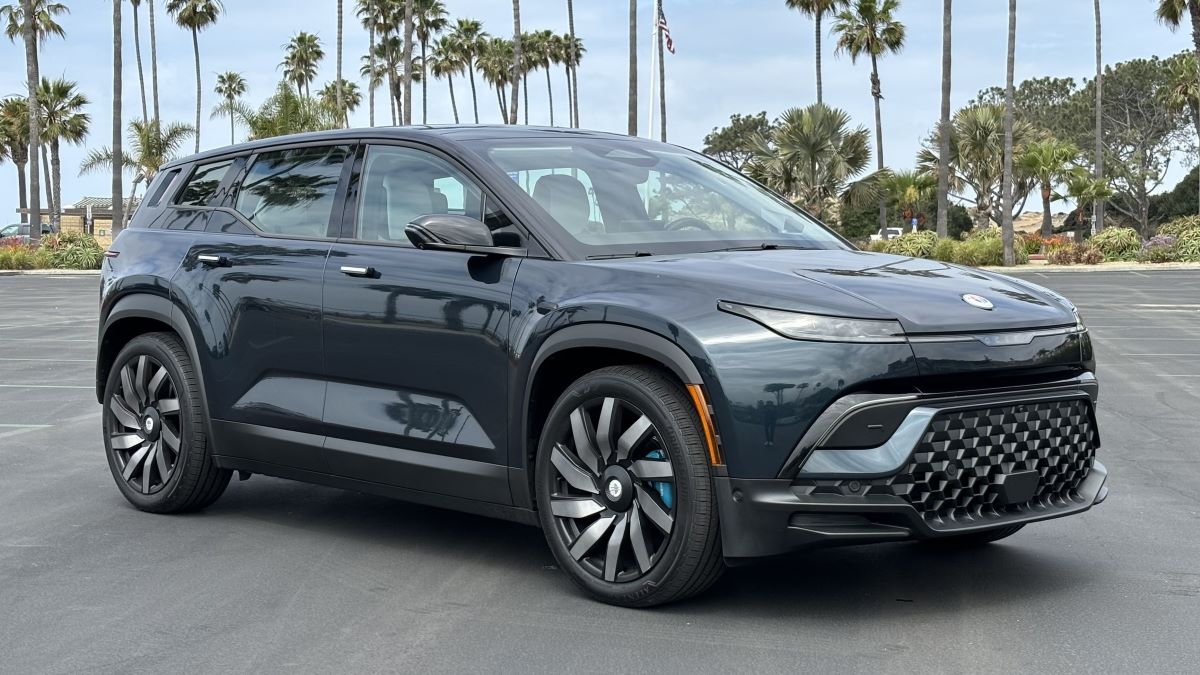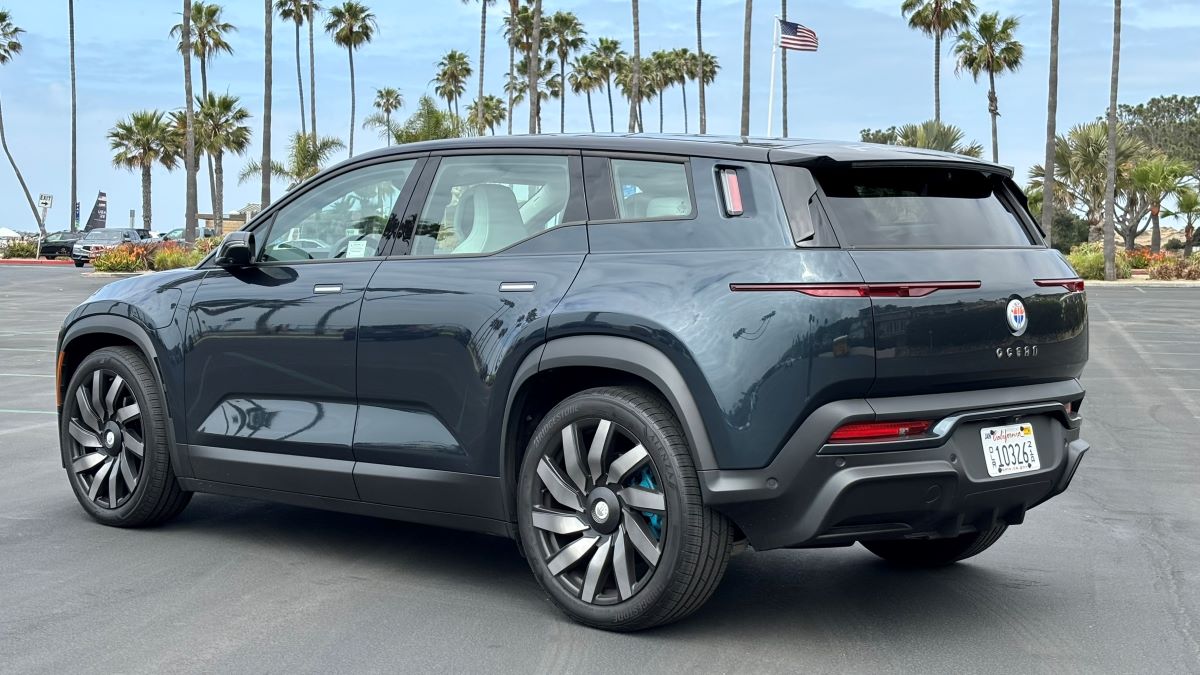2023 Fisker Ocean Review
By Matt Degen
Updated January 30, 2025
Pros
- Some nifty features
- Range
- Design and presence
Cons
- Lots of bugs to work out
- Mixed driving experience
- Future of company unknown
What's New?
- The Fisker Ocean is a brand new vehicle from a brand new company
On paper, the Fisker Ocean looks like an appealing new EV. It’s a compact SUV from a brand-new automaker that touts designer looks, great range, innovative ideas like a solar roof and rotating touchscreen, and a low starting price. In reality, though, the Ocean appears to be sinking before our eyes. We promise that will be the only oceanic pun we use in this review.
The Fisker Ocean enters the fledgling but rapidly growing class of 2-row electric SUVs, competing with the likes of the Hyundai Ioniq 5, Ford Mustang Mach-E, Kia EV6, Volkswagen ID.4, and Chevrolet Blazer EV. Each and every one of those rivals is a far better choice than the Fisker, which is plagued with problems in the present and faces a highly uncertain future. We wish that weren’t the case, because a fully baked Ocean backed by a fiscally strong Fisker could be a viable and compelling EV. Fingers crossed.
Fisker the automaker is new, but the name may sound slightly familiar. It’s the namesake of Henrik Fisker, and this is his second go at forming and helming an automaker after years as a car designer. His first company, Fisker Automotive, declared bankruptcy in 2013 after making just a few thousand cars. As we write this a decade later, his second car company is facing the same fate after selling its first batch of cars and currently not making any more.

What’s New for 2023
The Ocean marks the first car from Fisker Inc. Company founder Henrik Fisker previously unveiled other vehicles to follow, but the fact that production has ceased for the only car Fisker was making doesn’t bode well for the Ocean’s future, let alone other models from the brand
2023 Fisker Ocean Pricing
The Kelley Blue Book Fair Purchase Price for any individual used vehicle can vary greatly according to mileage, condition, location, and other factors, but here's a general idea of what buyers are currently paying for used 2023 Fisker Ocean models when purchasing from a dealership.
Power, Ride and Handling
The Fisker Ocean’s appeal and potential quickly fade as soon as you drive it. Possibly even before, as some initial customers found when they literally had trouble simply getting the key fob to work to allow entrance to the car or start it.
We were plagued by the latter. In our testing, the Ocean would not start until we waved the fob around a particular area near the steering wheel, as if wielding a wand like a sort of automotive Harry Potter. We had a brief feeling of success when the vehicle actually turned on, but things went downhill from there, especially on the uphills (more on that in a moment).
Like almost every other electric vehicle, the Fisker Ocean can be quick. That’s just the neat nature of electric motors. Glorious instant torque with the benefit of zero emissions. But in the 2023 Fisker Ocean, we found both acceleration and braking to be uneven. It’s difficult to evenly transition between the going and the stopping, especially when the brakes are set to max regen and the car is in its fleetest “Hyper” mode.
The Ocean’s overall ride and handling are also unsorted. Power delivery felt inconsistent in every driving mode, and we found driving the Ocean generally unsteady and confidence-sapping. Oddly, in the Eco mode acceleration lagged and lagged until it didn’t, like some sort of weird EV turbo lag.
“Even driving straight down the highway is more work than it should be,” noted our most senior test driver.
Our most alarming incident occurred when driving up a parking structure ramp. We took our foot off the accelerator pedal and, instead of holding itself in place, the Ocean just rolled backward until we hit the brake pedal. Help is on the way in the form of one-pedal driving functionality, which a Fisker spokesperson says is scheduled to be rolled out with an over-the-air software update at some point.
Dismal driving issues aside, we found the driver’s seat bottom curiously uncomfortable and the oddly shaped steering wheel made for tired hands. One of the few bright spots is the Fisker Ocean’s California mode, which lowers every window at the push of a single button (including the rear, like a Toyota 4Runner and some other SUVs) to create an open-air feeling while driving.
A few final notes from our log tell of a car whose turning radius feels large given the size of the Ocean, a too-abrupt lane-holding system, a left rear dome light that seemed possessed, wonky Bluetooth phone connectivity, and an infotainment screen that decided to freeze on one particular 20-minute drive. Oh, and the logo on the key fob for some reason looked as if it was disappearing before our eyes during our week of testing the Fisker Ocean.
Eco-conscious Interior

Aiming for sustainable production, the 2023 Ocean electric SUV has cabin materials made from recycled plastics and does not use any animal products. The interior design follows the current clutter-phobic trend (the air vents are adjusted using the infotainment screen, for example), but it’s not as sparse as a Tesla.
Unfortunately, we found materials in our top-of-the-line Ocean Extreme test vehicle middling. Some of the plastic pieces felt cheap, including the main control panel below the touchscreen that controls climate adjustment and other functions. Speaking of the touchscreen, it’s impressive in design, if not execution. It boasts a standard 17.1-inch touchscreen set into a vertical orientation when driving. A neat parlor trick, however, is the screen’s ability to rotate to a horizontal position when you’re parked, presenting a wide-screen display that can be used for entertainment while, say, you’re charging the vehicle. We found the graphics just OK, and bugs to be worked out in the system.
The driver’s seat isn’t all that comfortable, but rear-seat passengers will find good stretch-out space thanks to a flat floor. Our test model’s upholstery was dressed in white, and we bristle at the thought of what it might look like in a few years.
Blue Sky Thinking
Everyone will have their own opinion on the design of the Ocean, but subjectivity aside, we can objectively say it has some interesting design cues and features. Like Henrik Fisker’s first, albeit failed, attempt at making his own car (the Fisker Karma), the Ocean touts solar panels in the roof. Here it is said to be able to trickle charge the battery.
On the whole, our eyes found the Ocean cutely aggressive, with a sleek profile that includes door handles that retract into the body. The front fascia – to our eyes – looks like the car has a big ol’ menacing frown, while the rear is distinguished by perhaps the slimmest taillights we’ve ever seen.
Size-wise, the 2023 Ocean SUV is about the same length and height as a Tesla Model Y, but almost 3 inches wider. Or let’s say longer, lower, and wider than a Honda CR-V, if that’s a better frame of reference.
Our Favorite Features and Tech
App as Key
Using a smartphone app to access the vehicle is an increasingly common feature and comes as standard across the 2023 Ocean lineup.
Solar roof
Dubbed SolarSky, Fisker says the Ocean can add some 2,000 miles of range per year under ideal conditions thanks to solar panels charging the vehicle’s battery.
California Mode
With the press of a button, all the windows open, including one set into the liftgate, for when you really want a blast of sea air. This is standard in the top trims, but not available in the Sport version.
Revolving touchscreen
All versions of the new Ocean all-electric SUV have a large 17.1-inch infotainment touchscreen oriented vertically. But it can also rotate to a horizontal orientation, a capability that’s standard on the Extreme and One versions, optional on the others. Users can stream content while waiting for the Ocean to charge.
Park My Car
This self-parking feature, which Fisker says is for parallel and angled spaces, is standard in the Extreme and One models.
Two-way charging
The Ocean will offer the option to charge another electric vehicle, various appliances, or (with the right equipment) provide emergency power for a house.
Range and Charging
The Fisker Ocean is available in three trims. The entry-level Sport uses a single motor and is front-wheel drive, with an estimated range of 231 miles. The mid-level Ultra trim has dual motors, all-wheel drive, and estimated range of 350 miles. The Ocean Extreme has the same setup and a range estimate of 360 miles. We should note that, in our testing, that range estimate seemed generous.
For comparison, the Tesla Model Y has a maximum range of 330 miles, the Hyundai Ioniq 5 is rated at 303 miles, the Genesis GV60 can do 264 miles, and the larger Cadillac Lyriq manages 314 miles.
Fisker quotes a charging time of 34 minutes when going from 10% battery capacity to 80% on a DC fast charger. That’s a bit on the slow side, with a lot of rivals performing that same task in about 20 to 25 minutes. A full recharge on a 240-volt home charger could take up to 18 hours.

6-Year/60,000-Mile Warranty
Fisker’s new-vehicle warranty is for six years or 60,000 miles, whichever happens first. This includes roadside assistance. The all-electric powertrain and battery are protected for 10 years or 100,000 miles, with the battery covered for 75% efficiency.
2023 Fisker Ocean
KBB.com Consumer Reviews
Trending Topics in KBB.com Consumer Reviews
2023 Fisker Ocean Styles
Calculate Your Budget With These KBB.com Tools
Specifications
Dimensions, Weights & Capacities
Max Seating Capacity | 5 | ||
|---|---|---|---|
Towing Capacity, Maximum | 2040 lbs. |
Exterior
Alloy Wheels | Available | ||
|---|---|---|---|
Fog Lights | Available | ||
Number of Doors | 4 doors | ||
Panorama Moon Roof | Available | ||
Privacy Glass | Available | ||
LED Headlights | Available |
Mechanical
Drivetrain | FWD | ||
|---|---|---|---|
1 speed | Available | ||
Hill Start Assist | Available | ||
Parking Assist System | Available |
Performance
Engine | Electric Motor | ||
|---|---|---|---|
Estimated Electric Range | 250 miles | ||
Charge Time (240V) | Unavailable hours | ||
Battery Capacity | N/A |
Warranty
Basic | 6 years / 60000 miles | ||
|---|---|---|---|
Powertrain | 10 years / 100000 miles | ||
Corrosion | 12 years / Unlimited miles |
Comfort & Convenience
Entertainment
Interior
Seating
Security
Technology
2023 Fisker Ocean Safety
Safety Features & Technology
2023 Fisker Ocean Rankings
More Fisker Ocean News & Information
Starting up a new automaker is one of the hardest challenges in business. But the rise of electric cars has…
Electric car startup Fisker slashed prices on its supply of Ocean SUVs by as much as 39% late last week…
Electric vehicle (EV) builder Fisker may be headed for bankruptcy soon. The company announced today that it will halt production…




